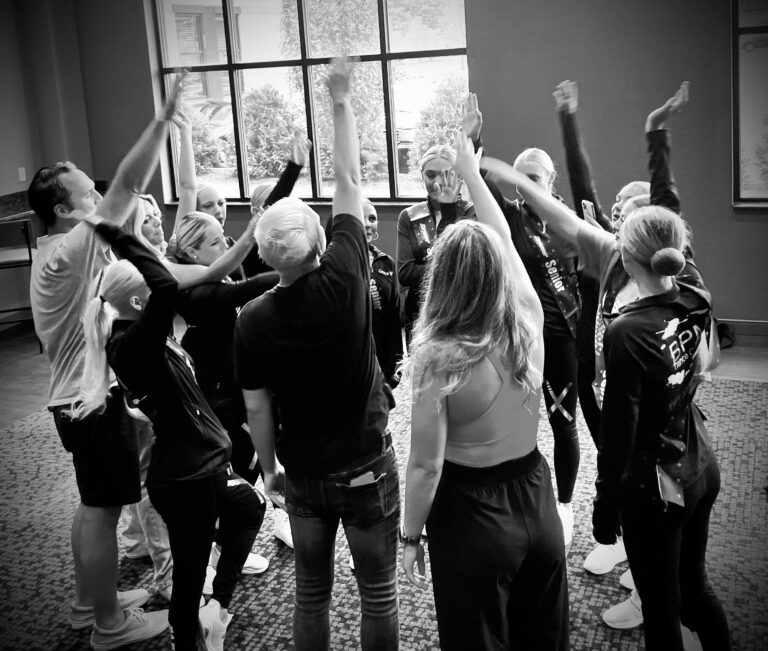
It can happen so quickly. One moment a promising student is strong and pushing their way forward to success, and then suddenly they begin to evaporate before your eyes. Research has consistently shown that dancers are at least three times as likely to experience an eating disorder compared to the general population. So even if you are doing everything “right,” you may still find yourself advocating for the wellness of a student battling disordered eating. By setting a proactive groundwork of support and confronting the issue head-on in the studio, you may have the power to change the movement of disordered eating in dance.
Why it happens
“That is always the hardest part,” says Pacific Northwest Ballet School managing director Denise Bolstad. “How did we get here?” At PNBS, teachers spend a lot of time talking internally about language they are using. “The teachers have a lot of power,” says Bolstad. “It could just be a comment they made and didn’t realize its impact.” Comparing dancers to “a herd of elephants” when they aren’t light enough on their feet may not be intended as a commentary on their physicality at all, but could be received that way.
The qualities that make a great dancer may also inherently predispose them to the high incidence of eating disorders, according to Sasha Gorrell, a former dancer and postdoctoral research scholar focusing on eating disorders at the University of California, San Francisco. She points out that most successful dancers are high achievers with a strong affinity for setting and achieving goals. “It’s a means to an end,” she says. “If your goal is to change your body shape, it is one of the possibilities.”
Immediate action
If you suspect that a dancer is suffering from an eating disorder, it is imperative that you act quickly. This confrontation may be best made by an administrator at the school if such a person is available. “Because the teachers are so involved with the kids, we try to take it out of their wheelhouse,” Bolstad says, adding that it is usually the teacher, a dorm counselor or other PNB leadership who notices and reports their concern.
If there is a concern with rapid weight loss, Bolstad will engage the parents right away. “It’s hard because it is horrifying for the parents,” she says. If things don’t improve, PNBS will insist the student see a mental health professional and even take time away from the studio. Parents’ anxieties can elevate if a student is asked to spend some time away, insisting that “taking dance away” will make it worse. “We have to redirect them to know that health is number one, and dance is number two,” Bolstad says. “Once they can settle with that, it gets easier.”
Addressing the class
It isn’t enough to address the issue with only the student who is suffering, because their peers have witnessed it as well. “It’s really traumatic for them,” says Nadine Kaslow, a psychologist who works with the Atlanta Ballet. “They feel pressure to get thinner, and that can escalate their own eating issues,” she says. “It scares them, and they don’t know who to turn to.” Kaslow encourages teachers to reach out to a mental health professional who can facilitate a conversation with the class. She adds that other dancers have likely been witnessing the behavior long before the teachers notice. “They don’t want to tattle, but they wish someone would do something. You can’t pretend that this isn’t going on.”
There is a lot of whispering that goes on in the studio, and it is normal for the student to be concerned with what their peers will think. While you should not share a student’s private information without their consent, Gorrell encourages having a candid conversation with the student about addressing their situation openly with their peers.
“Make sure the individual has the voice to be able to say ‘This would help me’ and share how they would like it to be handled.” One possible strategy is to “ask the student how they think their peers are feeling,” Gorrell says. “How would the student feel if they were witnessing a friend go through the same thing?” Once the dancer understands that the gossiping is really coming from a place of concern, they may be more willing to address it. Adds Gorrell: “They may just say to them, ‘I want you to know that I am OK. I am just taking some time off to take care of myself.’ And that may be all that it takes.”
Proactive prevention
Make candor about mental health issues part of your studio culture. “And not just around eating disorders,” says Gorrell. “Normalize the need to take time off when things aren’t balanced in your life. Whether that is depression or anxiety or grieving the loss of a relative, send the message that mental health is important, and it should be taken seriously.” Kaslow suggests having a conversation with the students at the beginning of every year to outline how the studio would handle an eating disorder if it were to happen, and be clear that teachers are always concerned with the well-being of the students.
Gorrell also encourages teachers to think about what values they may be projecting in the classroom, even unintentionally. Remarking on a dancer’s weight loss in the studio is never helpful to the dancer or their peers. “Make sure that comments made about bodies in front of the class not only implicitly but explicitly value strength,” she says.
PNBS has a long-term relationship with a psychologist, and her visits with the students not only help the dancers, they also alert Bolstad to potential issues that need to be addressed. “Recently they felt that the teachers had indicated some girls need to lose a little bit of weight, but shared with Toby that we hadn’t given the correct tools to do that,” she says. “It is never OK for a teacher to tell a student to lose weight, and I have never seen it be successful when addressed this way.”




